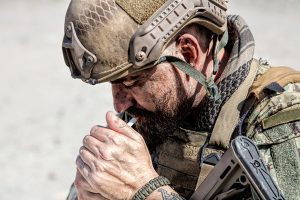Cigarette use a major health risk to military service members
Do you know someone in the military who smokes? Chances are you do. Military service members smoke 60 percent above that of the general population, which poses significant health risks to them.
According to the U.S. Centers for Disease Control and Prevention (CDC), approximately one in four (24 percent) of all active-duty military service members currently smoke. That number jumps significantly among the young male population—more than half (50.2 percent) of male veterans aged 18-25.5 smoke. Data from the Department of Defense indicates tobacco use costs the military approximately $1.6 billion annually in lost productivity and healthcare expenses.
In contrast, an estimated 14 percent of U.S. adults smoke cigarettes.
“Deployment is a factor,” says Captain Dennis Amundson, DO, a pulmonary medicine physician who was stationed with the Marines, Seabees and special operations forces during his 38 years in service. “New recruits face a range of stressors and at the same time, may enter a culture where smoking is more pervasive.”
While some military personnel may have used e-cigarettes or other tobacco products prior to entering the service, Dr. Amundson suggests the sheer prevalence of smoking may encourage service people to transition to cigarettes. And though vaping data is still inconclusive, there is a growing body of evidence that indicates the trial and experimentation of e-cigarettes among youth and young adults may lead to subsequent cigarette smoking.
“Deployment is a factor. New recruits face a range of stressors and at the same time, may enter a culture where smoking is more pervasive.”
As an osteopathic physician who still serves a large military population, Dr. Amundson counsels patients not to think of smoking as a stress reliever or method to pass time. He suggests that limiting access to cigarettes on base and raising prices discourages smoking. Research shows these tactics are effective deterrents among the military as well as the general public.
The health impact can be quick and severe
Brian H., who shares his story in the CDC’s Tips From Former Smokers® campaign, was a smoker when he joined the Air Force at 19. At 35, he suffered a heart attack that ended his military career.
“It’s hard to serve your country when you’re too weak to put on the uniform,” he shares in campaign videos designed to discourage tobacco use. Now 63, a heart attack and lung cancer survivor, he encourages young service members to understand that tobacco use may be the most dangerous part of their military career.
For more information on the CDC’s Tips campaign, including profiles of the former smokers, links to the ads, and free quit help, visit www.cdc.gov/tips.
Osteopathic physicians focus on prevention, tuning into how a patient’s lifestyle and environment can impact their well-being. DOs strive to help their patients be truly healthy in mind, body and spirit—not just free of symptoms. Learn more about the DO difference.

